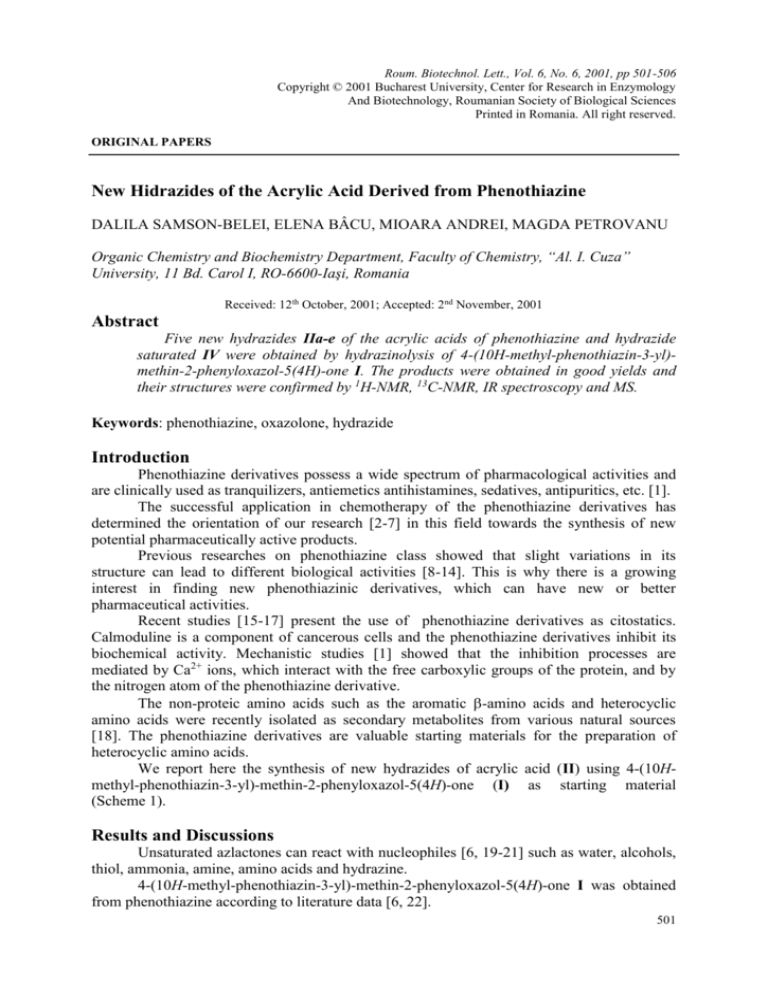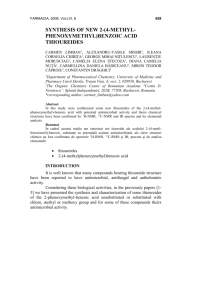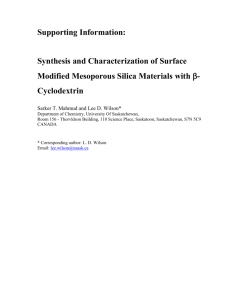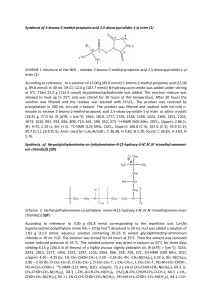
Roum. Biotechnol. Lett., Vol. 6, No. 6, 2001, pp 501-506
Copyright © 2001 Bucharest University, Center for Research in Enzymology
And Biotechnology, Roumanian Society of Biological Sciences
Printed in Romania. All right reserved.
ORIGINAL PAPERS
New Hidrazides of the Acrylic Acid Derived from Phenothiazine
DALILA SAMSON-BELEI, ELENA BÂCU, MIOARA ANDREI, MAGDA PETROVANU
Organic Chemistry and Biochemistry Department, Faculty of Chemistry, “Al. I. Cuza”
University, 11 Bd. Carol I, RO-6600-Iaşi, Romania
Received: 12th October, 2001; Accepted: 2nd November, 2001
Abstract
Five new hydrazides IIa-e of the acrylic acids of phenothiazine and hydrazide
saturated IV were obtained by hydrazinolysis of 4-(10H-methyl-phenothiazin-3-yl)methin-2-phenyloxazol-5(4H)-one I. The products were obtained in good yields and
their structures were confirmed by 1H-NMR, 13C-NMR, IR spectroscopy and MS.
Keywords: phenothiazine, oxazolone, hydrazide
Introduction
Phenothiazine derivatives possess a wide spectrum of pharmacological activities and
are clinically used as tranquilizers, antiemetics antihistamines, sedatives, antipuritics, etc. [1].
The successful application in chemotherapy of the phenothiazine derivatives has
determined the orientation of our research [2-7] in this field towards the synthesis of new
potential pharmaceutically active products.
Previous researches on phenothiazine class showed that slight variations in its
structure can lead to different biological activities [8-14]. This is why there is a growing
interest in finding new phenothiazinic derivatives, which can have new or better
pharmaceutical activities.
Recent studies [15-17] present the use of phenothiazine derivatives as citostatics.
Calmoduline is a component of cancerous cells and the phenothiazine derivatives inhibit its
biochemical activity. Mechanistic studies [1] showed that the inhibition processes are
mediated by Ca2+ ions, which interact with the free carboxylic groups of the protein, and by
the nitrogen atom of the phenothiazine derivative.
The non-proteic amino acids such as the aromatic -amino acids and heterocyclic
amino acids were recently isolated as secondary metabolites from various natural sources
[18]. The phenothiazine derivatives are valuable starting materials for the preparation of
heterocyclic amino acids.
We report here the synthesis of new hydrazides of acrylic acid (II) using 4-(10Hmethyl-phenothiazin-3-yl)-methin-2-phenyloxazol-5(4H)-one (I) as starting material
(Scheme 1).
Results and Discussions
Unsaturated azlactones can react with nucleophiles [6, 19-21] such as water, alcohols,
thiol, ammonia, amine, amino acids and hydrazine.
4-(10H-methyl-phenothiazin-3-yl)-methin-2-phenyloxazol-5(4H)-one I was obtained
from phenothiazine according to literature data [6, 22].
501
DALILA SAMSON-BELEI, ELENA BÂCU, MIOARA ANDREI, MAGDA PETROVANU
The reaction of compound I with hydrazines such as: hydrazine hydrate,
phenylhydrazine, 4-carboxy-phenylhydrazine, 4-aminomorpholine and 4-methyl-1-aminopiperazine, was the subject of our studies (Scheme 1).
CH3
N
CH3
N
O
S
O
N
NH NH R1
S
C6H5
I
O
+ H2N NH R1
NH C C6H5
O
IIa-e
II
H2N-NH-R1
Solvent
%
a
H2N-NH2
ethylic alcohol
85
b
H2N-NH-Ph
ethylic alcohol
80
c
H2N-NH-C6H4(p)-COOH
dioxane
53
O
dioxane
60
N CH3
dioxane
57
d
e
H2N N
H2N N
Scheme 1
The reactions occur by addition of the nucleophile to the carbon atom from the
carbonyl group (C5), with simultaneous opening of the oxazolone ring.
Generally the reaction takes place with non-stoechiometric amounts of hydrazine
derivatives. For phenylhydrazine and 4-carboxy-phenylhydrazine, 4 gram equivalent of the
hydrazine were needed. This procedure allowed us to obtain product II b,c in 80% and 53%
yield respectively.
In the case of 4-aminomorpholine and 4-methyl-1-amino-piperazine, 20 gramme
equivalent were necessary for the completion of the reaction. The use of only 2 gramme
equivalent led us to low yields and long reaction time.
In some cases we have used hydrazine hydrochloride, Na2CO3 and ethanol as solvents.
These conditions lead only to the esther III (Scheme 2).
I + HX· H2N NH R2
C2H5OH/Na2CO3
reflux
CH3
N
S
III
O
O C2H5
NH C C6H5
O
R2 = –COOH, –COOC2H5 , –CH3 , –OCH3
502
Scheme 2
Roum. Biotechnol. Lett., Vol. 6, No. 6, 501-506 (2001)
New hidrazides of the acrylic acid derived from phenothiazine
To avoid the formation the esther III, some reactions were carried out on dioxane with
free hydrazines.
In the case of unsubstituted hydrazine we have obtained two products, depending on
the reaction conditions. At room temperature, with a high excess of hydrazine hydrate (1:30),
the product IIa was obtained. At reflux, the excess of hydrazine determines the reduction of
the exocyclic double bond and the product IV was obtained in 54 % yield (Scheme 3):
I
+ H2N NH2 excess
C2H5OH/reflux
CH3
N
O
2h
S
IV
NH NH2
CH2 CH
NH C C6H5
O
Scheme 3
All products were purified by flash chromatography and their structure was
established by chemical and spectral analyses (IR, 1H-NMR, 13C-NMR, MS).
Structure of compound IV was confirmed by 1H-NMR and mass spectrometry. In the
1
H-NMR there are three aliphatic signals: singlet at 3.24 ppm corresponding to the CH3 group
of the N-phenothiazine, doublet at 2.91 ppm (CH2) and quartet at 4.57 ppm corresponding to
the CH. This shows that we have a saturated C-C bond. The mass spectrum also confirmed
the proposed structure as the molecular ion M+ appears at m/e = 418 and the fragment resulted
from tropylic fragmentation of the heterocycle (Het-CH2) appears at m/e = 226.
For the unsaturated products IIa, we have no aliphatic signal except for the CH3 group
of the N-phenothiazine. The proton from the double bond of the acrylic group appears
(Het-CH=C-) superposed with the protons of the phenothiazine ring. The hydrogen from NH2
of the hydrazine group gave a signal at 4.37 ppm in case IIa and at 4.32 ppm in case IV.
The IR spectra characterize the compounds IIa-e and IV as hydrazides. The string in
the 1790 cm-1 region (typical for the carbonyl group of - unsaturated -lactones)
disappears, being replaced by broad strings in the 1590-1680 cm-1 region, typical for the
amide and hydrazide C=O groups. The vibrations of the N–H bond appear at 3100-3250 cm-1.
Materials and Methods
The melting points were determined with a MEL-TEMP II apparatus and are not
corrected. The IR spectra were recorded on a SPECORD 71 spectrometer in KBr pellets. The
1
H- and 13C-NMR spectra were recorded on a BRUCKER AM-300 spectrometer using
DMSO-d6 as solvent. The mass spectra were recorded by a RIBEN-10-10 spectrometer.
-Benzoylamino--(10H-methyl-phenothiazin-3-yl)-acrylhydrazide (IIa)
2.5 mL of hydrazine hydrate (98%) were added to a suspension of 4-(10H-methylphenothiazin-3-yl)-methin-2-phenyloxazol-5(4H)-one I, 0.5 g (1.3 mmol) in 10 mL ethanol.
The mixture was stirred at room temperature, for 15 min. when the reaction was completed
(follow TLC). The product precipitated from the reaction mixture was filtered and further
purified. The pure product was obtained as yellow needles with m.p.= 217-219°C (lit. 208209°C [16]), from ethanol.
Roum. Biotechnol. Lett., Vol. 6, No. 6, 501-506 (2001)
503
DALILA SAMSON-BELEI, ELENA BÂCU, MIOARA ANDREI, MAGDA PETROVANU
Analysis: C23H20N4O2S (416); calcd: 66.34 %C, 4.8 % H, 13.46 %N, 7.69 %O,
7.69 %S; found: 64.62 %C, 5.1 %H, 14.01 %N, 7.80 %O, 8.47 %S
1
H-NMR (DMSO-d6), , ppm: 3.26 (s, 3H, N-CH3); 4.37 (s, 2H, NH2); 6.89-8.01 (m,
12Haromatic and 1Holefinic); 9.44 and 9.77 (s, 1H, NHCO).
13
C-NMR (DMSO-d6), , ppm: 35.1 (CH3); 114.3, 114.7, 121.4, 121.7, 122.7, 126.7,127.2,
127.4, 127.8, 128.0, 128.1, 128.5, 129.4, 131.5, 133.8, 144.5, 145.3 (CH and C aromatic);
164.3 and 165.7 (2 CONH).
2-Benzoylamino-3-(10H-methyl-phenothiazin-3-yl)-propionhydrazide (IV)
5 mL of hydrazine hydrate (98%) were added to 0.5 g (1.3 mmol) oxazolone I, in 20
mL ethanol. The mixture was stirred at reflux for 2h and allowed to cool. After evaporation of
the solvent, the solid obtained was collected and crystallized from ethanol. The pure product
was obtained as white needles with m.p.= 165-167°C from ethanol.
Analysis: C23H22N4O2S (418) ; calcd : 66.02 %C, 5.26 % H, 13.4 %N, 7.65 %O,
7.66 %S; found: 65.3 %C, 5.7 %H, 12.6 %N, 8.3 %O, 8.1 %S
1
H-NMR (DMSO-d6), , ppm: 2.91 (d, 2H, CH2); 3.24 (s, 3H, N-CH3); 4.32 ( NH2); 4.57 (q,
1H, CH); 6.81-7.80 (m, 12Haromatic); 8.53 (d, 1H, NHCO); 9.26 (s, 1H, NHCO).
13
C-NMR (DMSO-d6), , ppm: 35.0 (CH3); 36.3 (CH2); 53.7 (CH); 114.1, 114.4, 121.5,
121.8, 122.2, 126.6, 127.4, 127.6, 128.0, 128.3, 131.2, 132.5, 134.0, 143.5, 145.3 (CH and C
aromatic); 166.1 and 170.5 (2 CONH).
Mass spectrum m/z (intensity %) M+ = 418 (8); 213 (75); 198 (69); 226 (10).
-Benzoylamino--(10H-methyl-phenothiazin-3-yl)-acryl-N-phenylhydrazide (IIb)
1 mL (5.2 mmol) of phenylhydrazine was added to 0.5 g (1.3 mmol) oxazolone I, in
20 mL ethanol. The mixture was stirred at reflux for 40 min, when the reaction was completed
(follow TLC). The product precipitated from the reaction mixture was filtered and further
purified. The pure product was obtained as yellow needles with m.p.= 237-239°C from
ethanol.
Analysis: C29H24N4O2S (492) ; calcd : 70.73 %C, 4.87 % H, 11.38 %N, 6.50 %O,
6.50 %S; found: 68.3 %C, 5.7 %H, 11.6 %N, 7.23 %O, 7.17 %S
1
H-NMR (DMSO-d6), , ppm: 3.29 (s, 3H, N-CH3); 6.67-8.05 (m, 17Haromatic and 1Holefinic);
9.97 (s, 1H, NHCO); 10.37 (d, 1H, NHCO).
13
C-NMR (DMSO-d6), , ppm: 35.3 (CH3); 111.6, 113.6, 113.9, 117.4, 120.4, 120.8, 121.8,
125.8, 126.5, 126.6, 126.9, 127.2, 127.3, 127.5, 128.6, 130.6, 132.7, 143.3, 144.3, 148.2 (CH
and C aromatic); 163.7 and 164.6 (2 CONH).
-Benzoylamino--(10H-methyl-phenothiazin-3-yl)-acryl-N-(4-carboxyphenyl)hydrazide (IIc).
1 g (5.2 mmol) of 4-carboxy-phenylhydrazine were added to 0.5 g (1.3 mmol)
oxazolone I, in 20 mL dioxane. The mixture was stirred at reflux for 20 h, when the reaction
was completed (follow TLC). The solvent was distilled off and the residue was
chromatographed on alumina with ethyl acetate and hexane (1:1) as eluent. The pure product
was obtained as yellow needles with m.p.= 200-203°C.
Analysis: C30H24N4O4S (536) ; calcd : 67.16 %C, 4.47 % H, 10.44 %N, 11.94 %O,
5.97 %S; found: 65.8 %C, 4.7 %H, 12.6 %N, 11.3 %O, 5.6 %S
1
H-NMR (DMSO-d6), , ppm: 3.37 (s, 3H, N-CH3); 6.86-8.83 (m, 16Haromatic and 1Holefinic);
10.14 and 10.23 (2s, 2H, 2NHCO); 12.27 (s, 1H, COOH).
13
C-NMR (DMSO-d6), , ppm: 35.2 (CH3); 111.1, 116.3, 119.8, 122.1, 124.1, 124.3, 127.5,
128.0, 128.4, 130.7, 131.8, 132.2, 133.0, 133.6, 139.0, 139.2, 153.3 (CH and C aromatic);
165.3 and 166.3 (2CONH); 167.3 (COOH).
504
Roum. Biotechnol. Lett., Vol. 6, No. 6, 501-506 (2001)
New hidrazides of the acrylic acid derived from phenothiazine
-Benzoylamino--(10H-methyl-phenothiazin-3-yl)-acryl-N-(morpholin)-amide (IId).
2 mL (26 mmol) of aminomorpholine were added to 0.5 g (1.3 mmol) oxazolone I, in
20 mL dioxane. The mixture was stirred at reflux for 15 min. when the reaction was
completed (follow TLC). The solvent was distilled off and the residue was chromatographed
on alumina with chloroform and acetone (7:3) as eluent. The pure product was obtained as
yellow needles with m.p.= 176-178°C.
Analysis: C27H27N4O3S (487) ; calcd : 66.52 %C, 5.54 % H, 11.5 %N, 9.85 %O,
6.57 %S; found: 65.78 %C, 5.34 %H, 12.01 %N, 9.50 %O, 7.37 %S
1
H-NMR (DMSO-d6), , ppm: 2.83 (t, 2·2H, CH2-N); 3.28 (s, 3H, N-CH3); 3.62 (t, 2·2H,
CH2-O); 6.91-8.31 (m, 12Haromatic and 1Holefinic); 9.20 (s, 1H, NHCOPh); 9.86 (s, 1H,
NHCOmorpholine).
13
C-NMR (DMSO-d6), , ppm: 35.1 (CH3); 54.3 (CH2-N); 66.0 (CH2-O); 114.3, 114.7, 121.4,
121.7, 122.7, 126.8, 127.2, 127.8, 128.3, 128.5, 129.4, 131.6, 133.6, 144.5, 145.2 (CH and C
aromatic); 163.3 and 165.6 (2 CONH).
-Benzoylamino--(10H-methyl-phenothiazin-3-yl)-acryl-N-(4-methyl-piperazinyl-1)amide (IIe).
2 mL (26 mmol) of 1-amino-4-methyl-piperazine were added to 0.5 g (1.3 mmol)
oxazolone I, in 20 mL dioxane. The mixture was stirred at reflux for 20 min. when the
reaction was completed (follow TLC). The solvent was distilled off and the residue was
chromatographed on alumina with chloroform and acetone (7:3) as eluent. The pure product
was obtained as yellow needles with m.p.= 111-113°C.
Analysis: C28H29N5O2S (499) ; calcd : 67.2 %C, 6 % H, 14 %N, 6.4 %O,
6.4 %S; found: 66.3 %C, 5.7 %H, 13.6 %N, 7.3 %O, 7.1 %S
1
H-NMR (DMSO-d6), , ppm: 2.18 (s, CH3-Npiperazine); 2.33 (t, 2·2H, N(CH2)2 piperazine); 3.29
(s, 3H, N-CH3); 3.40 and 3.55 (2t, 2·2H, NH-N(CH2)2 piperazine); 6.28-7.98
(m, 12Haromatic and 1Holefinic); 9.80 and 10.19 (s, 2 NHCO).
13
C-NMR (DMSO-d6), , ppm: 35.1 (CH3); 45.6 (CH3-Npiperazine); 54.2 ( (CH2)2Npiperazine);
114.4, 114.7, 121.5, 121.8, 122.5, 122.6, 126.6, 127.2, 127.7, 127.8, 128.4, 128.6, 128.8,
131.8, 133.1, 144.6, 144.8 (CH and C aromatic); 165.4 and 167.2 (2 CONH).
Conclusions
The use of 4-(10H-methyl-phenothiazin-3-yl)-methin-2-phenyloxazol-5(4H)-one I as starting
material we synthesised five new hydrazides of -benzoylamino--(10H-methylphenothiazin-3-yl)-acrylic acid IIa-e and 2-benzoylamino-3-(10H-methyl-phenothiazin-3-yl)propionhydrazide IV.
New complex components with Fe(III), Cu(II), Cr(III) and Pd(II) were obtained using
hydrazide IIb as ligand [23].
Hydrazide IV was utilized as ligand (L) [24], yielding a new series of Cu(II) complex
components
with
the
general
formula
[CuL(OH2)2Cl2],
[Cu2L(OH2)2Cl4],
[Cu2L2(OH2)2Ac2]Ac2 and [Cu2L(OH2)2Ac4].
References
1. R. R. GUPTA, Bioactive Molecules. Phenothiazines and 1,4-Benzothiazines, Chemical
and Biological Aspects, ed. Elsevier, Amsterdam, vol. 4 (1988).
2. E. BÂCU, M. PETROVANU, P. GRANDCLAUDON, A. COUTURE, Phosporus, Sulfur
and Silicon, 108, 231-237 (1996).
Roum. Biotechnol. Lett., Vol. 6, No. 6, 501-506 (2001)
505
DALILA SAMSON-BELEI, ELENA BÂCU, MIOARA ANDREI, MAGDA PETROVANU
3. E. BÂCU, M. PETROVANU, C. ANTOHIE, I, CIOCOIU, O. C. MUNGIU, Ann.
pharmaceutiques françaises, 55, 269-271 (1997).
4. E. BÂCU, M. PETROVANU, P. GRANDCLAUDON, A. COUTURE, Roum.
Biotechnol. Lett., 2, 383-389 (1997).
5. E. BÂCU, M. PETROVANU, P. GRANDCLAUDON, A. COUTURE, Phosporus, Sulfur
and Silicon, 149, 207-220 (1999).
6. E. BÂCU, M. PETROVANU, P. GRANDCLAUDON, A. COUTURE, Rev. Roum. Chim.,
44(7), 699-703 (1999).
7. E. BÂCU, M. PETROVANU, P. GRANDCLAUDON, Rev. Roum. Chem., 44(3), 231-234
(1999).
8. P. L. ALVARADO, C. AVENDANO, M. T. GRANDE, J. C. MENENDEZ,
Heterocycles, 31, 1983-1987 (1990).
9. N. MOTOHASHI, S. R. GOLLAPERDI, J. EMRANI, K. R. BHARTIPROLU, Cancer
Invest., 9, 305 (1991).
10. Y. SHUKLA, S. D. SRIVASTAVA, Indian J. Chem. Sect. B, 33(4), 397-399 (1994).
11. E. LUKEVICS, M. TRUSHULE, S. GERMANE, I. TUROVSKI, Chem. Heterocyclic
Comp., 33(2), 229-233 (1997).
12. A. SPARATORI, C. B. CANU, B. V. FABIO, Farmaco, 44(10), 945-950 (1989).
13. A. ANDREANI, M. RAMBALDI, A. LOCATELLI, P. ARESCA, R. BOSSA, I.
GALATULAS, Eur. J. Med. Chem., 26(1), 113-116 (1991).
14. A. ANDREANI, M. RAMBALDI, A. LOCATELLI, Pharm. Acta Hev., 67(8), 234-236
(1992).
15. K. C. GEORGE, B. B. SINGH, Indian J. Exp. Biol., 22, 305-307 (1984).
16. P. SEEMAN, D. GRIGORIADIS, H. B. NIZNIK, Drug Develop. Res., 9, 63-67 (1986).
17. K. C. GEORGE, B. B. SINGH, Brit. J. Cancer, 45, 309-313 (1982).
18. B. STANOVNIK, J. SVETE, M. TIŠLER, J. Heterocyclic. Chem., 24, 1809 (1981).
19. A. M. TRIKDARI, A. K. MUKERJEE, Indian J.Chem. Sect. B, 27B, 81-83 (1988).
20. J. CORNFORTH, D. MING-HUI, J. Chem. Soc. Perkin Trans I, 1459-1462 (1990).
21. C. BODEA, I. OPREAN, V. FĂRCĂŞAN, Rev. Roum. Chim., 14, 673-678 (1969).
22. C. BODEA, V. FĂRCĂŞAN, I. OPREAN, Rev. Roum. Chim., 10, 1103-1109 (1965).
23. S. PASOLESCU, E. BÂCU, D. SAMSON, I. CIOCOIU, V. ILUC, L. MELITA, C.
GURAN, 5th International Symposium on Applied Bioinorganic Chemistry, Corfu-Greece,
1999.
24. E. Bâcu, C. Guran, I. Ciocoiu, V. Iluc, An. Şt. Univ. “Al. I. Cuza” Iaşi, Tom IV, 29-34
(1998).
506
Roum. Biotechnol. Lett., Vol. 6, No. 6, 501-506 (2001)








